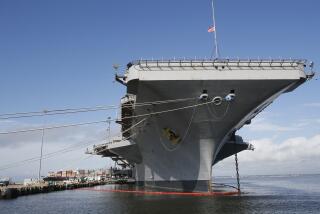Four Navy Missile Systems Hit by Defects, GAO Says
- Share via
The Navy has been forced to banish nearly half a billion dollars worth of Phoenix Aim-54c missiles, its most modern air-to-air weapon, to storage bunkers during the last four years because of a defective part produced by a small contractor in Orange County, according to a federal government report.
The Phoenix is just one of four major tactical missile systems that are riddled with design problems and manufacturing defects, according to a General Accounting Office report released Tuesday by Rep. John D. Dingell (D-Mich.), chairman of the House Energy and Commerce Committee’s investigations and oversight subcommittee.
“All of these missiles have significant defects,” an investigator working under Dingell said Tuesday. “The Navy is interested in schedule first, quality second and cost third. Right now, we are depending on these missiles in the Persian Gulf.”
Navy officials generally disputed the implication that their missiles are defective but acknowledged that many of the individual problems disclosed in the GAO report are accurate. They said they could not respond to the report formally until they finish studying it.
Some Navy officials also questioned whether the Navy had been specifically targeted for criticism by the GAO. “They only picked Navy weapons. If they really wanted to go after the bad guys, they could have picked a few in the Air Force and Army that don’t look too good,” said one who requested anonymity.
The subcommittee said it plans to call a hearing on the missile quality issue next month. The GAO report, which summarizes one year of investigative work, details numerous technical problems with some of the Pentagon’s most important tactical missiles, including the Phoenix, Sparrow, Harpoon and Harm.
The Phoenix, produced by Culver City-based Hughes Aircraft, fared the worst in the GAO report. The radar-guided missile, which costs $1.3 million each, is carried by the F-14 fighter plane and is designed to attack enemy aircraft more than 100 miles away. The Navy plans to buy 7,204 Phoenix Aim-54c missiles at a cost of $6.8 billion.
Problems with the Phoenix’s “safety and arming device,” which ignites the missile motor and warhead, has prevented the Navy from sending the new missiles to the fleet, the GAO said.
Instead, the Navy is continuing to use an older version of the Phoenix, the secret details of which are thought to have been compromised when some of the missiles apparently were passed into Soviet hands by Iran after the Iranian revolution of 1979. The new missile is more resistant to Soviet countermeasures.
According to the GAO report, about 250 new Phoenix missiles were in storage bunkers at the Hughes Aircraft plant in Tucson at the end of August. A committee investigator said Tuesday that the number in storage is now 370. The bunkers at Tucson will be filled by the end of this month, the GAO report says.
Meanwhile, two-thirds of the warranty period on at least some of the missiles has expired during the period that they have been in storage, a subcommittee investigator said, because the government has already accepted delivery from Hughes.
The safety and arming device is produced by Micronics International, a Brea contractor that has about 100 employees. Telephone calls to the company Tuesday were answered by an answering machine tape recording that said none of the company officials were available.
The Navy contracts directly with Micronics for the missile device and supplies it to Hughes. As a result, Hughes is not held responsible for the problems with the device.
Major Quality Problems
Nonetheless, Hughes has plenty of its own problems with the Phoenix program, according to the GAO report. The company drew national attention in 1984 when it experienced major quality problems, causing Hughes to invest about $160 million in plant improvements at Tucson. But the company continues to be dogged by problems.
In July, the Navy rejected a shipment of Phoenix missiles when they could not pass quality acceptance tests, according to a Navy statement issued Tuesday. Hughes remains at least a year and a half behind schedule in producing the Phoenix missile, Navy officials said Tuesday.
A Hughes spokesman said the company had not seen the GAO report.
The Sparrow missile--a medium-range, air-to-air, radar-guided missile made by Raytheon, based in Lexington, Mass.--also has experienced a number of quality problems, according to the GAO report.
The Sparrow’s wings were improperly cut by an Inglewood subcontractor, Marvin Engineering. The wings would not properly fold up and the missiles would not fit into their launching tubes, the report said.
The problem came to light when the Greek navy told the U.S. Navy of its problems with Sparrows that it had purchased, the GAO report said. The U.S. Navy had apparently gotten around the problem by forcing the wings to close.
In January, 1987, the Navy issued an urgent bulletin to the fleet after identifying 5,721 defective wings. Marvin Engineering agreed to correct the problem at no cost to the government and, as of July, 4,000 wings had been fixed.
“I thought I did a great thing for the government, not a bad thing,” said Marvin Gussman, president of the company, in a telephone interview Tuesday. “I’ve got letters from the Navy commending me for a good job. We even went to Greece and fixed their missiles.”
Another critical problem with the Sparrow is with the detonator for the warhead, produced by Caelus Devices Inc. of Hollister, Calif. The GAO report said the detonators lack some of the explosive compound specified by the Navy.
As of July, the Navy had examined 7,222 suspect detonators and found 225 defective. The Navy has not decided whether to recall all of the missiles.
More to Read
Sign up for Essential California
The most important California stories and recommendations in your inbox every morning.
You may occasionally receive promotional content from the Los Angeles Times.














